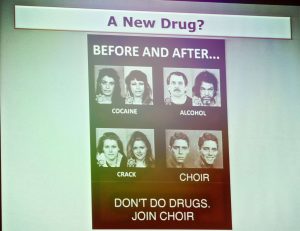By Isabelle Bonenkamp (Jutland Station).
“Music is experienced, performed and shared by people in all societies, ages and social groups. Recently, neuro-scientific interest in music has increased dramatically as modern brain imaging techniques have provided researchers the means to investigate the living human brain at work,” writes the Centre for Music in the Brain on the Aarhus University Website. To show some of their recent findings, a conference titled “Music in the Brain” was held on SPOT Festival 2016. One of the topics was the clinical application of music.
Listening to and creating music is an activity that releases dopamine in our body. It activates the reward system—working like drugs such as cocaine and alcohol. Consequently, the use of music in healthcare becomes increasingly popular. Bjørn Petersen, associate professor at Aarhus University and a musician himself, presented in his speech three ways of including music therapy into medical treatment:
 As a painkiller: Research shows that patients with Fibromyalgia – a disorder that causes fatigue and muscle pain throughout the body – report about increased mobility and reduced pain after having listened to self-chosen, relaxing music. Music works in this case as distraction from the pain through the dopamine secretion. So, one can leave the painkillers in the drawer and listen to a favourite song instead!
As a painkiller: Research shows that patients with Fibromyalgia – a disorder that causes fatigue and muscle pain throughout the body – report about increased mobility and reduced pain after having listened to self-chosen, relaxing music. Music works in this case as distraction from the pain through the dopamine secretion. So, one can leave the painkillers in the drawer and listen to a favourite song instead!
In cases of severe Dementia: Also known as senility, dementia is a brain disease marked by memory disorders, personality changes, and impaired reasoning. In the case of most progressive dementias, including Alzheimer’s disease, there is no cure and no treatment that slows or stops its progression. But there are ways to improve the symptoms – one of them is music. As shown in the documentary Alive inside even people who do not recognize their family anymore and had to be moved to a healthcare facility wake up when they listen to music that is familiar to them. The patients dance and sign along although being otherwise incapable to cope with everyday life.
Deaf people: Thanks modern technology deaf people can regain their hearing sense by getting a device implemented in their ear. These people are referred to in literature as ‘CI Users’ – Cochlear Implant Users – who have to undergo a lot of listening therapy and speech training. These programs however are not always successful and can be considered as not helpful by the patients. Therefore, Bjørn Petersen focused his research on the effect of musical training for especially young CI-users. In his recently published paper Wrap it in rap! – Music Making with Adolescent CIUsers (2015) he concluded that musical training would be a very effective and motivational activity for CI-Users, having let them participate in a short intensive training program involving group-based music making activities (e.g. rapping and singing): “In particular, rapping and creation of rap lyrics may form an appealing and relevant element in future training programs; the CI facilitates it well, it has a strong and repetitive focus on language, articulation, rhythm and rhyme.”
The Danish National Research Foundation’s Centre for Music In the Brain (MIB) is an interdisciplinary research centre at Aarhus University and the Royal Academy of Music, Aarhus/Aalborg, Denmark. They focus on the clinical application of music and are combining neuro-scientific, musicological and psychological research for understanding music perception, action, emotion and learning. Especially relevant are their findings to the Danish Sound Innovation Network as they run a cooperation entitled „Sound & Health“ from January 2016-2018 with the goal to build up a knowledge platform creating further growth and innovation in Denmark using sound.

